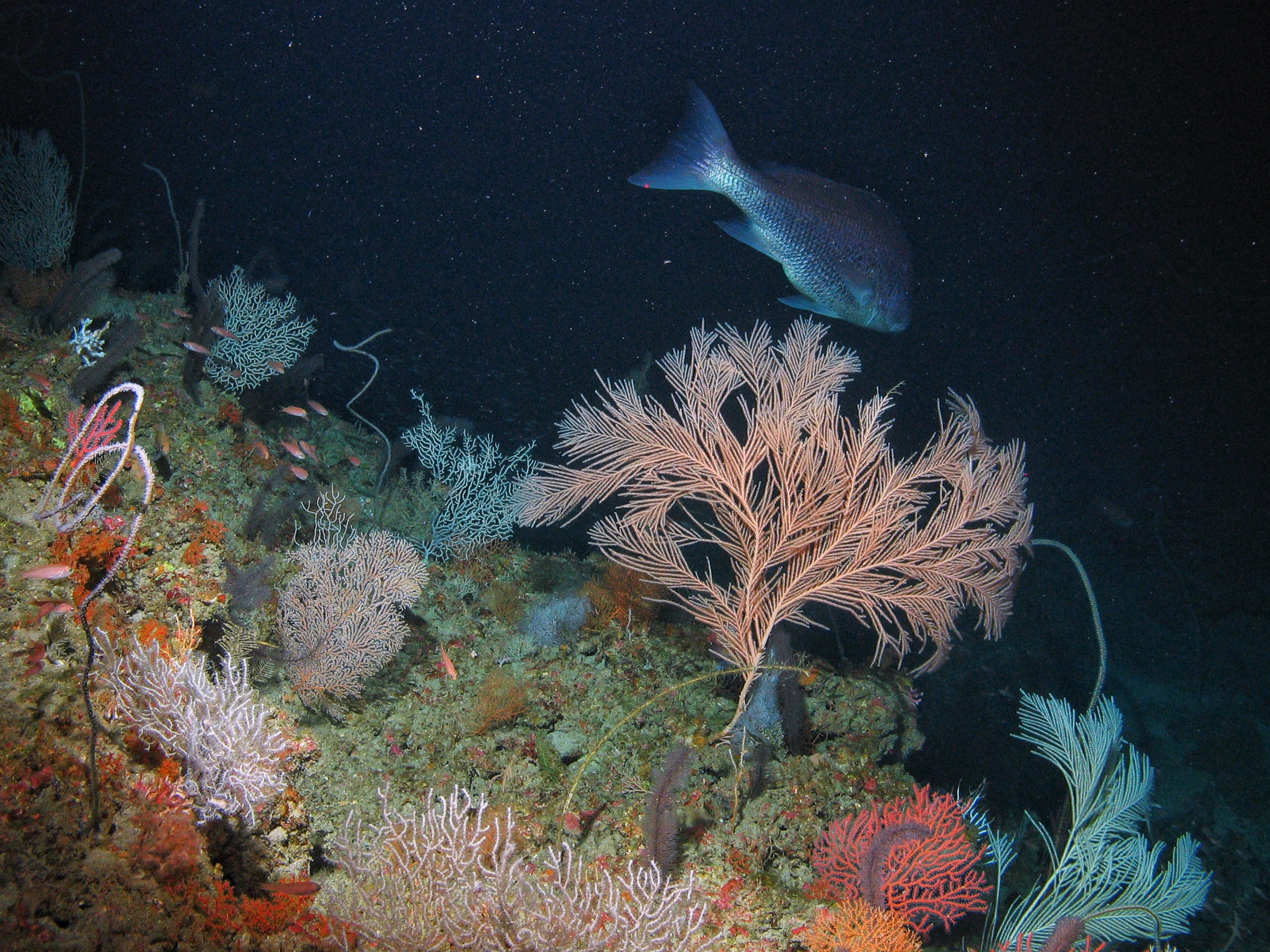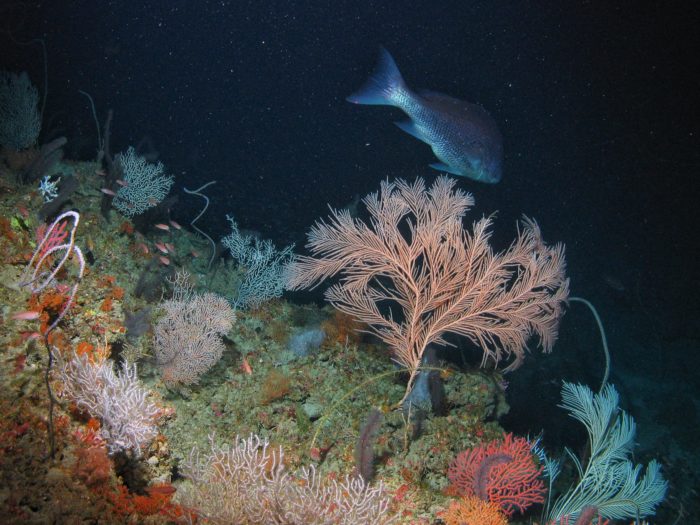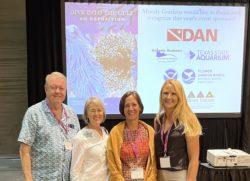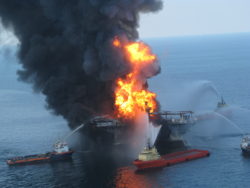
Blue Beacon: Marine Sanctuaries & Gulf Restoration

A mesophotic coral reef in the Gulf of Mexico. Photo taken during a remotely-operated vehicle dive under research permit #FGBNMS-2022-005. Credit: NOAA/MARE
Written by Kelly Martin, NOAA Program Analyst, serving as the Project Manager for the Mesophotic and Deep Benthic Communities Active Management and Protection project
While national marine sanctuaries and other designated marine protected areas are critical for conserving incredible marine habitats, these places play another important role: they aid in the restoration of other ocean habitats impacted by human activity. To highlight the importance of marine protected areas in the Gulf of Mexico, the National Marine Sanctuary Foundation convened a panel during Moody Gardens’ “Dive Into the Gulf” Exposition in Galveston, Texas, and as a part of the Foundation’s ongoing Blue Beacon Series. Kris Sarri, President and CEO of the National Marine Sanctuary Foundation, moderated the panel. She was joined by Dr. Larry McKinney, Chair of Gulf Strategies at the Harte Research Institute, and Kelly Martin, a project manager within the Mesophotic and Deep Benthic Communities restoration portfolio at NOAA.
On April 20, 2010, the Deepwater Horizon mobile drilling unit exploded, causing the tragic loss of 11 lives and a massive release of oil from the BP Exploration and Production Inc. (BP) Macondo well, resulting in extensive injuries to natural resources. The spill ultimately became the largest offshore oil spill in U.S. history. Approximately 134 million gallons of oil – equivalent to the volume of over 200 Olympic-sized swimming pools – spilled into the ocean over the course of 87 days.
Thousands of square kilometers of mesophotic and deep benthic habitat surrounding the Deepwater Horizon wellhead suffered impacts from the spill. Found hundreds to thousands of feet below the surface of the Gulf of Mexico, these vibrant communities are essential habitat for coral, fish, and invertebrates of all kinds. Mesophotic coral reefs are critical for connectivity to their shallow water coral counterparts and to other ecosystems across the Gulf of Mexico.
Fortunately, direct impacts from the Deepwater Horizon oil spill were not observed in Flower Garden Banks National Marine Sanctuary, one of 15 nationally-significant marine sanctuaries across the nation that gained its name from the colorful sponges, plants, and marine life along the sanctuary’s seafloor. These healthy mesophotic and deep ecosystems within the sanctuary now serve as a baseline to compare to ongoing recovery at other sites across the Gulf of Mexico that were directly impacted by the spill.
At the time of the spill, Flower Garden Banks National Marine Sanctuary included three banks – East and West Flower Garden Banks and Stetson Bank – covering 56 square miles. In 2021, the boundaries of the sanctuary were expanded to include 14 new banks and a total of 160 square miles of the Gulf. Thriving mesophotic and deep benthic ecosystems can be found within most of the new sanctuary boundaries, ensuring the important role they will continue to play in restoration work and the protection of these ecosystems for generations to come.
This year, Flower Garden Banks National Marine Sanctuary celebrates the 30th anniversary of its designation. In October 2022, our nation also will celebrate 50 years of national marine sanctuaries. The Blue Beacon panel hosted by Moody Gardens is part of the Save Spectacular campaign to celebrate the 50th anniversary of the National Marine Sanctuary System.
The Importance of Collaboration

From L to R: Larry McKinney, Paula Jeannine McKinney, Kris Sarri, and Kelly Martin.
The importance of collaboration and the interconnectivity of people and ecosystems across the Gulf were recurring themes at the forefront of the Blue Beacon panel’s discussion. During the event, Dr. McKinney shared his saying, “We may not know the answer ourselves, but we know the people who do,” while referencing the collaboration that Harte Research Institute has fostered between experts from the United States, Mexico, and Cuba in response to environmental challenges shared across political boundaries.
This includes the agreement signed between the United States and Cuba in 2015 to collaborate on science, outreach and education in their “sister” marine protected areas: the Guanahacabibes National Park and San Antonio Bank in Cuba, and Flower Garden Banks and Florida Keys National Marine Sanctuaries in the United States.
In discussing NOAA’s ongoing efforts to restore mesophotic and deep benthic communities in the Gulf as a result of the Deepwater Horizon oil spill, Martin highlighted the vital role that Flower Garden Banks National Marine Sanctuary and the National Marine Sanctuary Foundation play in reaching restoration goals.
Building Partnerships for Gulf Restoration
NOAA and the National Marine Sanctuary Foundation are building connections and partnerships that will help complete some of the identified goals of the restoration work by leveraging the sanctuary and Foundation’s expertise and capacity. In the coming years, this includes the development of education and outreach initiatives to connect the public to these deep ecosystems, the coordination of a corps of highly qualified technical divers who can undertake restoration activities at depths beyond what recreational SCUBA divers can reach, and exciting work with cutting edge technologies and analytic approaches to explore and better understand these ecosystems for the purpose of restoration.
History and Legacy of Deepwater Horizon
Following an oil spill like the Deepwater Horizon spill, the Natural Resources Damage Assessment process establishes a council of trustees to assess the injuries to natural resources, followed by the development and implementation of a restoration plan. In the case of Deepwater Horizon, the trustees include both federal agencies and representative agencies from each of the five Gulf states.

Fire boat response crews battle the blazing remnants of the offshore oil rig Deepwater Horizon, April 21, 2010. Photo credit: NOAA
Ultimately, these trustees reached a settlement with BP to resolve BP’s liability for natural resource injuries from the spill. Under this settlement, BP will pay up to $8.8 billion over 15 years for restoration. The Programmatic Restoration Plan developed by the trustees identified 13 different “restoration types” to be restored through a comprehensive and integrated ecosystem-level restoration approach. Many species and habitats that suffered publicly visible damage in the wake of the oil spill, such as birds, sea turtles, and nearshore environments, are included in these restoration types.
The plan includes a restoration type far out of the public eye: mesophotic and deep benthic communities. In total, the Deepwater Horizon trustees committed more than $126 million for restoration of mesophotic and deep benthic communities in their 2019 restoration plan. The National Oceanic and Atmospheric Administration (NOAA) and its partners are undertaking a variety of restoration activities, such as mapping the seafloor to more accurately identify where mesophotic and deep benthic communities are located; investigating the biodiversity and connectivity of these habitats across the Gulf; and closely studying the coral species that provide vital structure in these habitats to better understand their life cycles and their potential for propagation.

Retrieving the ROV Beagle from the Gulf after a dive to a Mesophotic reef. The partnership between NOAA and the National Marine Sanctuary Foundation will support work with remotely operated vehicles like this one. Photo credit: Kelly Martin/NOAA
All of this work will inform efforts to restore habitat and reduce threats such as invasive species, marine debris, and impacts from abandoned oil and gas infrastructure. Information from these activities will also support the management entities that are responsible for making decisions about protected areas in the Gulf of Mexico, such as the Gulf of Mexico Fisheries Management Council and the Flower Garden Banks Sanctuary Advisory Council.
Despite the significant challenge that the damage from the Deepwater Horizon oil spill poses, the future of the Gulf of Mexico is bright. Thanks to the dedicated work of and partnerships between scientists, managers, government agencies, nonprofit organizations, and engaged members of the public, significant strides have been made since that fateful day in 2010.
To learn more about restoration work in the Gulf of Mexico and follow the progress, visit www.gulfspillrestoration.noaa.gov.
This was the first event in 2022 of the Foundation’s Blue Beacon Series, which brings to light the pressing issues facing our ocean and great lakes. We hope you will join us on September 18th for the next Blue Beacon Series event at the New York Aquarium, as we Dive into Hudson Canyon! For more information, visit marinesanctuary.org/bluebeacon.
